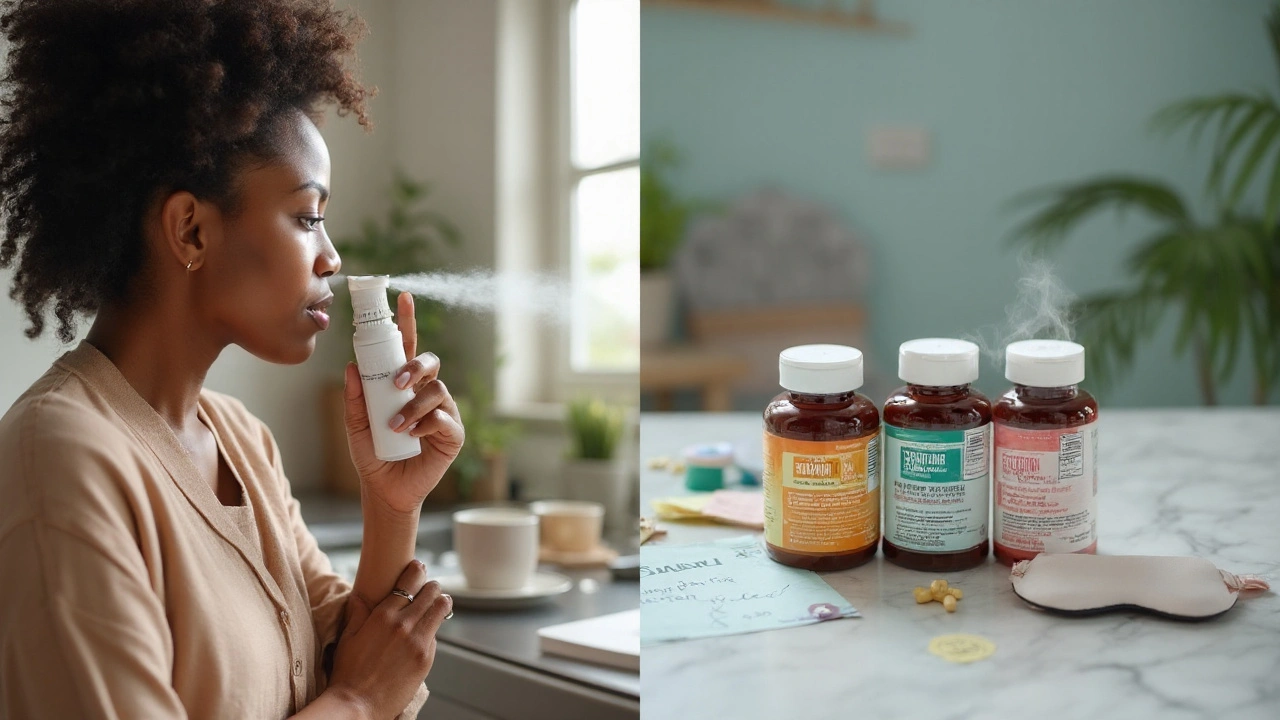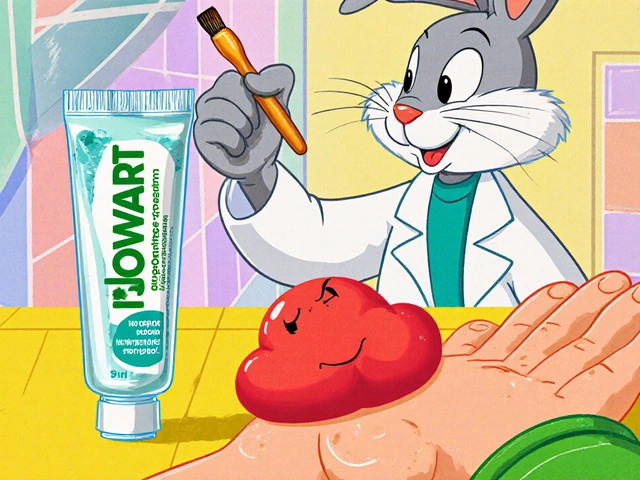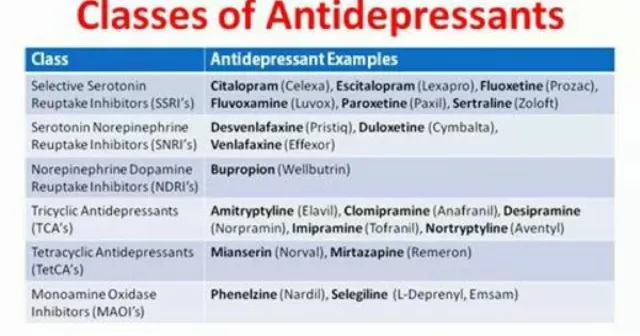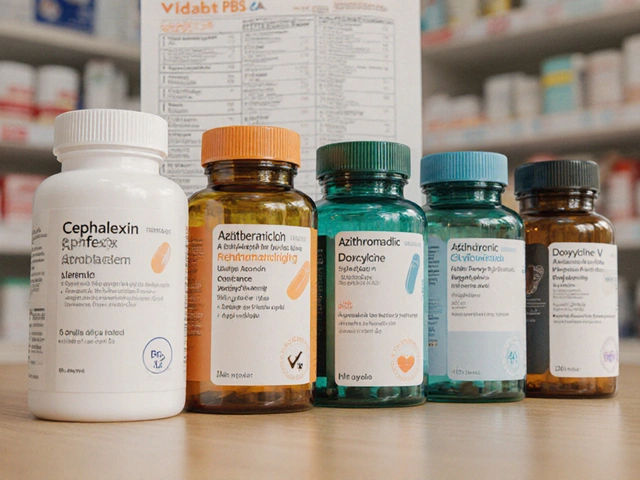
You want relief that actually works, and fast. Azelastine is often pitched as the quicker, stronger option for a stuffed, itchy nose-especially compared with the typical allergy pill. That’s true in the right situations, but it’s not the best fit for everyone, every day. Here’s the no-nonsense breakdown so you can pick with confidence and stop sneezing through your morning. For what it’s worth, my Labrador, Max, is a walking pollen magnet, so I’ve road-tested most of this in real life.
TL;DR:
- Need fast relief and help with congestion? Azelastine (nasal) works in about 15-30 minutes and beats oral pills on stuffiness.
- Want a once-daily, non-drowsy routine? Fexofenadine or loratadine are easy daytime options; cetirizine/levocetirizine are stronger but more sedating for some.
- Worst symptoms or year-round rhinitis? Azelastine + a nasal steroid (e.g., fluticasone) is often stronger than either alone.
- Hate bitter taste or nasal sprays? Stick with oral antihistamines; for itchy eyes, use antihistamine eye drops.
- First-generation pills (like diphenhydramine) make many people groggy and are risky for older adults-save them for emergencies, not daily use.
What to Compare: The Decision Criteria That Actually Matter
Think in terms of jobs to be done: how fast do you need relief, which symptoms hurt most, how sensitive are you to drowsiness, and how much hassle can you tolerate? That framework keeps the choice simple and personal.
- Speed: If you want quick relief before a meeting or school run, intranasal antihistamines like azelastine nasal spray kick in faster (often within 15-30 minutes). Most oral antihistamines take about an hour.
- Congestion control: Oral antihistamines help sneezing, itching, and runny nose more than true stuffiness. Intranasal antihistamines do better with congestion, and they pair well with intranasal steroids when stuffiness is the big issue.
- Drowsiness risk: First-gen antihistamines (diphenhydramine) are sedating. Among modern pills, fexofenadine and loratadine are less likely to cause drowsiness; cetirizine and levocetirizine help more but make some people sleepy. Azelastine (nasal) can cause mild drowsiness in a minority-try the first dose at home.
- Coverage of eye symptoms: For itchy, watery eyes, oral antihistamines help, and intranasal antihistamines help a bit. Dedicated antihistamine eye drops (azelastine or olopatadine) are fastest for eyes.
- Dosing and convenience: Fexofenadine, loratadine, and many nasal steroids are once daily. Azelastine nasal is often twice daily (some use once daily 0.15% OTC). Bitter taste is a real thing for azelastine-technique matters (more below).
- Budget and access: OTC options are cheap and easy. Branded combos can get pricey, though generics have helped. Prices vary a lot by store and insurance.
- Kids, pregnancy, and special cases: Azelastine nasal is OTC down to age 6 in the U.S. For pregnancy, many clinicians prefer loratadine or cetirizine; use nasal azelastine only if benefits outweigh risks. For older adults, avoid sedating first-gen drugs.
Guidelines back this up. The AAAAI/ACAAI Rhinitis Practice Parameter (2020 update with continuing reviews through 2023) and ARIA updates say intranasal steroids are the strongest monotherapy for moderate-severe allergic rhinitis. Intranasal antihistamines are equal to or better than oral antihistamines for nasal symptoms and congestion, and the azelastine-steroid combo can outperform either alone in many trials.
Head-to-Head: Azelastine vs Popular Antihistamines
Here’s the side-by-side view you can use when picking something at the pharmacy or talking with your clinician.
| Option | Route | Onset | Duration | Typical Dosing | Sleepiness | Congestion Relief | OTC / Rx (US) | Age (US label) | Typical Monthly Cost (USD, 2025) | Notable Notes |
|---|---|---|---|---|---|---|---|---|---|---|
| Azelastine (Astepro) nasal | Intranasal | ~15-30 min | ~12-24 h | 1-2 sprays/nostril 1-2×/day | Low-moderate risk in some | Good | OTC (0.15%) | ≥6 years | $15-35 | Fast; bitter taste possible; technique matters |
| Azelastine (Optivar) eye drops | Ophthalmic | ~10-15 min | ~8-12 h | 1 drop/eye 2×/day | None | Eyes only | Rx/Generic widely available | ≥3 years | $8-25 | Best for itchy, watery eyes |
| Olopatadine nasal | Intranasal | ~30 min | ~24 h | 2 sprays/nostril daily | Low | Good | Rx | Varies by brand | $25-60 | Alternative to azelastine nasal |
| Cetirizine | Oral | ~1 h | ~24 h | 10 mg daily | Moderate for some | Fair on congestion | OTC | Kids liquid available | $4-15 | Strong symptom control; can cause drowsiness |
| Levocetirizine | Oral | ~1 h | ~24 h | 5 mg nightly | Moderate for some | Fair | OTC | Kids liquid available | $8-20 | Similar to cetirizine; often more sedating |
| Fexofenadine | Oral | ~1 h | ~24 h | 180 mg daily | Low | Fair | OTC | Kids liquid/ODT | $6-18 | Good daytime choice for drivers/pilots |
| Loratadine | Oral | ~1-3 h | ~24 h | 10 mg daily | Low | Fair | OTC | Kids liquid/chew | $4-12 | Gentle, less potent; often pregnancy go-to |
| Desloratadine | Oral | ~1-3 h | ~24 h | 5 mg daily | Low | Fair | Rx/OTC varies by region | Kids liquid | $6-20 | Active metabolite of loratadine |
| Diphenhydramine | Oral | ~30-60 min | ~4-6 h | 25-50 mg q6-8h | High | Fair | OTC | Use caution | $3-10 | Sedating; avoid for daily use esp. in older adults |
| Azelastine + fluticasone (combo) | Intranasal | ~30 min | ~24 h | 1 spray/nostril 2×/day or daily | Low-moderate | Very good | Rx (generic available) | Check label | $25-90 | Often best for moderate-severe rhinitis |
Notes: Onset and duration are typical estimates. Costs vary by store, insurance, and dose size. Always check the product label for age limits and exact directions.
Best For / Not For: Quick Matches by Situation
Use these snap judgments when you’re deciding at the shelf or planning a longer-term routine.
- Azelastine nasal (Astepro):
- Best for: Fast relief; nasal congestion; nonallergic (vasomotor) rhinitis; predictable exposure (yard work, pet visit) where timing matters.
- Not for: People who hate nasal sprays or bitter taste; those who got drowsy from it before; anyone who won’t use it consistently.
- Pro tip: Aim spray slightly out toward the ear, not the septum; sniff gently, don’t inhale hard. That reduces drip and taste.
- Oral second-gen antihistamines (fexofenadine, loratadine, cetirizine, levocetirizine):
- Best for: Daily symptom prevention; itchy nose/throat/sneezing; people who prefer pills.
- Pick fexofenadine/loratadine for lowest drowsiness risk; pick cetirizine/levocetirizine if you need more punch and can tolerate possible sleepiness.
- Not for: Heavy congestion as the main symptom.
- Combo azelastine + fluticasone (generic Dymista):
- Best for: Moderate-severe allergic rhinitis; mixed symptoms (itching, sneezing, runny nose, plus congestion); when single agents fail.
- Not for: People who only have mild, rare symptoms.
- Evidence: Multiple RCTs show combo outperforms either alone for total nasal symptom score.
- Antihistamine eye drops (azelastine or olopatadine):
- Best for: Itchy, watery eyes that pills don’t fully cover.
- Not for: Nasal symptoms-you’ll still need nasal or oral therapy.
- First-gen antihistamines (diphenhydramine):
- Best for: Short-term rescue at night if nothing else is available.
- Not for: Daily use, older adults, or anyone who needs to be sharp; linked to confusion, falls, and anticholinergic effects.

Real-World Scenarios and Trade-Offs
These are the patterns I see again and again-at home, with readers, and in clinic conversations.
- The morning meeting problem: You wake up stuffed and need to be clear in under an hour. Azelastine nasal is your best quick fix. If you’re very sensitive to drowsiness, consider fexofenadine plus a saline rinse today, and plan ahead with a nasal steroid for the rest of the week.
- Pet visit (hi, Max): If you’re heading to a friend’s house with a shedding dog, use azelastine nasal 30 minutes before you go. Add an oral antihistamine if you get itchy eyes. Shower and change clothes after.
- Dusty house, year-round symptoms: Start a daily nasal steroid (fluticasone, triamcinolone). If congestion and sneezing linger, add azelastine nasal or switch to the combo spray.
- Outdoor pollen surge: On high-count days, a once-daily oral pill is easy. If you still feel stuffed, layer in azelastine nasal during the worst weeks.
- Drivers, pilots, heavy machinery: Use fexofenadine or loratadine during the day. Try azelastine nasal at night first to see if it makes you drowsy before using it on workdays.
- Itchy, watery eyes dominate: Add azelastine or olopatadine eye drops. They calm the eyes within minutes.
- Nonallergic (vasomotor) rhinitis: Triggers like perfumes, temperature changes, or smoke. Intranasal antihistamines (azelastine) often help more than pills here.
Technique tips to reduce azelastine’s bitter taste and drip:
- Blow your nose gently first.
- Keep your head level, not tilted back.
- Aim the nozzle slightly outward (toward the ear), away from the septum.
- Spray while sniffing gently. Don’t “snort” it back.
- Spit out any fluid that reaches your throat; don’t swallow it.
A quick decision tree you can follow:
- If you need fast relief and your nose is stuffed → Azelastine nasal. If severe or chronic, consider azelastine + fluticasone.
- If you want simple daily prevention with low risk of drowsiness → Fexofenadine or loratadine.
- If you need stronger symptom control and can handle some drowsiness → Cetirizine or levocetirizine.
- If eyes are the main problem → Antihistamine eye drops; add a pill or nasal spray as needed.
- If you’re pregnant → Talk to your clinician; loratadine or cetirizine are often preferred.
What the Evidence and Guidelines Say (2025)
Here’s the short, practical read of the best available guidance and studies as of 2025.
- Intranasal steroids are the strongest single therapy for moderate-severe allergic rhinitis (ARIA 2020/2023 updates; AAAAI/ACAAI Practice Parameter 2020). They reduce inflammation broadly, not just histamine’s effects.
- Intranasal antihistamines (like azelastine) start faster than intranasal steroids and often beat oral antihistamines for nasal symptoms, especially congestion (Practice Parameter 2020; multiple RCTs since). They’re a solid first-line choice when speed matters or oral pills haven’t helped enough.
- Combination therapy (azelastine + fluticasone) outperforms either alone on total nasal symptom scores in several randomized trials (e.g., Carr et al. 2012; Meltzer et al. 2015; subsequent meta-analyses). Patients feel better sooner and more completely.
- Oral second-gen antihistamines remain a safe, convenient base for many with mild-to-moderate pollen allergies. Fexofenadine and loratadine have the lowest sedation risk; cetirizine/levocetirizine provide stronger itch/sneeze control but can make some people sleepy.
- First-gen antihistamines like diphenhydramine cause significant drowsiness and anticholinergic effects. The 2023 AGS Beers Criteria flags them as potentially inappropriate for older adults because of confusion, falls, and cognitive effects-use sparingly and short-term.
Safety snapshots (from FDA labels and practice parameters):
- Azelastine nasal has low systemic absorption; common complaints are bitter taste, nasal irritation, and occasional drowsiness. Avoid alcohol if you’ve felt sedated by it.
- Oral second-gen antihistamines have low side-effect rates. Cetirizine/levocetirizine can cause drowsiness and dry mouth. Fexofenadine is the least sedating in studies that measured driving performance.
- Pregnancy and breastfeeding: Loratadine or cetirizine are often preferred if a systemic antihistamine is needed. Nasal azelastine may be considered if benefits outweigh risks, given low absorption; discuss with your OB.
Cost and access in 2025:
- Astepro (0.15% azelastine) is OTC; a month’s supply ranges roughly $15-35 depending on size and shop. Generics for Rx azelastine exist and can be cheap with discounts.
- Oral antihistamines are widely available for a few dollars per month.
- Combo azelastine + fluticasone is often covered, now with generics, but prices vary-expect $25-90/month without strong insurance coverage.
Citations (no links): AAAAI/ACAAI Rhinitis Practice Parameter (2020) with ongoing evidence updates through 2023; ARIA 2020/2023; FDA Astepro (azelastine HCl) nasal label (latest revision 2023); Carr W et al., randomised trials on azelastine/fluticasone combo; Meltzer EO et al., combo vs monotherapy; Cochrane reviews on intranasal antihistamines; 2023 AGS Beers Criteria.
Mini‑FAQ
- How fast does azelastine nasal work? Most people feel relief within 15-30 minutes. That’s faster than most pills.
- Does azelastine make you sleepy? It can. Many people don’t notice it, but a minority feel drowsy. Try your first dose at night or when you’re not driving.
- Can I use azelastine with a nasal steroid? Yes. The combo is often the most effective plan for moderate-severe symptoms.
- Is there rebound congestion with azelastine? No. Rebound congestion is from decongestant sprays (like oxymetazoline), not antihistamines.
- What if the taste is awful? Fix technique (aim outward, gentle sniff) and don’t tilt your head back. A sip of water after can help. If it’s still a deal-breaker, switch to pills or a different spray.
- What’s safest in pregnancy? Many clinicians prefer loratadine or cetirizine if a pill is needed. Talk to your OB before starting anything. Nasal steroid sprays are often used; azelastine may be considered if benefits outweigh risks.
- Which pill is least sedating? Fexofenadine generally. Loratadine is also low-sedation. Cetirizine and levocetirizine help more but can make some people sleepy.
- Can kids use azelastine nasal? Yes, check the label. The OTC 0.15% spray is labeled for ages 6 and up in the U.S.

Next Steps and Troubleshooting
Pick the path that matches your situation.
- I want fast, reliable relief: Start azelastine nasal once or twice daily. If symptoms are heavy or year-round, add a daily nasal steroid or ask about the combo spray.
- I need something simple for mild seasonal allergies: Try fexofenadine or loratadine once daily. Reassess in 3-5 days. If congestion persists, add azelastine nasal during peak weeks.
- I get drowsy on everything: Use fexofenadine in the morning. Test azelastine nasal at night on a day off; if it’s fine, you can use it before high-exposure moments.
- My eyes are the worst: Add azelastine or olopatadine eye drops. Combine with your usual pill or spray.
- Pregnancy planning or breastfeeding: Stick to options with the strongest safety record (often loratadine or cetirizine). Confirm with your clinician before changes.
- Still miserable after 2-4 weeks: Check your nasal spray technique, add a saline rinse, and talk to an allergist. You may be a candidate for immunotherapy (allergy shots or tablets).
- Budget tight: Use store-brand oral antihistamines and saline. Add OTC azelastine during bad flares instead of daily.
Allergies can be sneaky and personal. The good news: when you match the med to the job-speed, congestion, eyes, or long-term control-you usually get your day back. I do, even when Max barrels through a field and brings spring right into the living room.





Tony Bayard
September 5, 2025 AT 19:30When I first tried the nasal spray on Max during a thunderstorm of pollen, I was stunned by how quickly his sneezing halted.
Within fifteen minutes, the usual frantic nose‑rubbing stopped, and I could finally enjoy a quiet walk.
That speed is precisely why azelastine shines for anyone in a rush – a meeting, a class, a dog‑walk, you name it.
But the magic comes with a trade‑off: the bitter taste that can linger if you spray the wrong way.
My technique – aim slightly outward, keep the head level, and sniff gently – turned that nuisance into a non‑issue.
Remember, the spray’s systemic absorption is low, so side‑effects are rare, yet a minority feel a touch of drowsiness, especially if they’re sensitive to antihistamines.
If that happens, use the first dose at home before you head out, and you’ll know whether it’s a deal‑breaker.
For chronic sufferers, pairing azelastine with a nasal steroid creates a one‑two punch that outperforms either alone, as the studies in the post confirm.
Cost‑wise, an OTC bottle sits at about fifteen to thirty‑five dollars a month, which is a modest price for that rapid relief.
Contrast that with daily oral pills that can cost less but take longer to work and often leave congestion unresolved.
Also, unlike decongestant sprays, azelastine won’t cause rebound congestion, so you can use it safely for weeks.
The only real drawback is the dosing schedule – most products recommend twice a day, though once‑daily 0.15% options exist for those who despise the hassle.
If you’re a driver or pilot, you’ll appreciate that the drowsiness risk is far lower than with first‑gen antihistamines like diphenhydramine.
Pregnant or breastfeeding patients should chat with their clinician, but the low systemic profile makes it a reasonable option when benefits outweigh any tiny risk.
In short, azelastine is the sprint athlete of antihistamines: fast, powerful, and best used when you need immediate relief without the crash.
Jay Crowley
September 12, 2025 AT 12:50The nasal spray works fast and the taste fades quickly if you aim correctly.
sharon rider
September 19, 2025 AT 06:10From a broader perspective, the choice of antihistamine often mirrors one’s lifestyle priorities.
Those who value swift symptom control may gravitate toward intranasal formulations, while others prefer the convenience of a nightly pill.
The cultural acceptance of a spray versus a pill can also influence adherence, especially in households with children.
It is worth noting that the sensory experience, such as the bitter after‑taste, can shape user perception of efficacy.
Thus, the decision matrix extends beyond pharmacodynamics to encompass personal and societal factors.
swapnil gedam
September 25, 2025 AT 23:30I’ve been testing nasal antihistamines for a year on my own allergies and have noticed a few patterns.
The speed of relief is undeniable – most people feel less stuffiness within half an hour.
However, the cost can add up if you’re using the branded version weekly; generics help but aren’t always available everywhere.
Technique matters a lot – a simple tweak like directing the spray away from the septum reduces the bitter after‑taste dramatically.
For those with mixed symptoms, adding a mild steroid after a few days of azelastine can boost the overall control without extra side‑effects.
Lastly, keep an eye on drowsiness; a small number of users report mild sleepiness, so testing at home before a workday is wise.
Michael Vincenzi
October 2, 2025 AT 16:50That’s a solid point about technique; I’ve seen many newcomers spray straight back and then complain about taste.
Just a gentle sniff does the trick and keeps the spray where it belongs.
Courage Nguluvhe
October 9, 2025 AT 10:10The pharmacokinetic profile of azelastine demonstrates minimal systemic bioavailability, thereby limiting central nervous system penetration.
This accounts for the relatively low incidence of somnolence compared to first‑generation agents.
Moreover, its antagonistic action on H1 receptors within the nasal mucosa provides localized decongestion without the rebound effect seen in oxymetazoline.
From a formulary standpoint, the 0.15% OTC preparation offers a cost‑effective alternative to prescription‑only concentrations.
Oliver Bishop
October 16, 2025 AT 03:30I love the quick relief, especially before a big presentation.
Just make sure you aren’t driving right after the first dose if you feel any drowsy.
Alissa DeRouchie
October 22, 2025 AT 20:50Honestly I think the whole hype is overblown – people act like it’s a miracle cure when it’s just another spray.
Sure it works faster than a pill but the taste is like a bitter birthday cake that you can’t get rid of.
And the price? You could buy a whole month’s supply of cheap pills and still have change left.
Everyone jumps on the azelastine bandwagon without considering the long‑term budget.
Emma Howard
October 29, 2025 AT 13:10YES! That spray is a game‑changer!!
Fast relief and you can still stay alert for that marathon of tasks!!
dee gillette
November 5, 2025 AT 06:30While many praise azelastine for its rapid onset, a thorough evaluation must consider the cost‑effectiveness relative to oral antihistamines.
One could argue that the marginal gain in speed does not justify the higher expense, especially for patients with mild seasonal symptoms.
Furthermore, the potential for taste disturbances may reduce compliance, undermining the purported advantages.
In a controlled setting, the overall patient satisfaction may not significantly differ from a well‑chosen oral agent.
Thus, clinicians should weigh these factors before universally recommending the nasal spray.
Jasin P.
November 11, 2025 AT 23:50Oh great, another “miracle” spray – as if we haven’t seen this song before.
Try it, see if you like the after‑taste of defeat.
Lily Đàn bà
November 18, 2025 AT 17:10Let’s be real: the spray’s faster relief is only impressive if you can tolerate that metallic after‑taste.
People who hate the sensation will quit faster than the pollen clears.
Also, the price point makes it a luxury for many families fighting a budget. The “best for congestion” claim is valid, but only when you’re willing to pay extra for the occasional drowsy feeling.
Bottom line – it’s a niche product, not a universal solution.
Joseph O'Sullivan
November 25, 2025 AT 10:30Yo, if you’re looking for a quick fix, just spray and chill.
The stuff works like a charm, no need to overthink the science.
Conor McCandless
December 2, 2025 AT 03:50In the grand theater of allergy management, azelastine steps onto the stage as a swift, albeit temperamental, protagonist.
Its rapid onset, often within fifteen to thirty minutes, is akin to a sudden flash of insight that cuts through the fog of nasal congestion, offering a dramatic reprieve that oral antihistamines merely flirt with over the course of an hour.
Yet, this alacrity is not without its shadows; the bitter taste and occasional drowsiness paint a subtle chiaroscuro, reminding the user that even the brightest actors bear flaws.
The plot thickens when one considers the synergistic duet with intranasal steroids – a harmonious duet that, according to multiple randomized controlled trials, amplifies symptom control beyond the sum of its parts, delivering a crescendo of relief that sustains up to twenty‑four hours.
Financially, the narrative is a mixed bag: the over‑the‑counter version whispers affordability, while the branded and combination formulations thunder with higher costs, demanding a careful budgeting subplot for the cost‑conscious.
Moreover, the audience of patients must be stratified.
Those with acute, episodic exposure – the commuter who dreads pollen spikes or the pet owner bracing for a dog‑scented barrage – will find the rapid act of azelastine most compelling.
In contrast, the chronic sufferer with year‑round rhinitis may prefer the steady rhythm of daily oral antihistamines, whose sedative side‑effects are marginal and whose convenience aligns with a static routine.
The cultural reception of nasal sprays versus pills adds another layer, as societal comfort with a spray can vary, influencing adherence as much as the pharmacodynamics.
Meanwhile, safety data crowns azelastine with low systemic absorption, a modest drowsiness profile, and an absence of rebound congestion – a triumphant victory over decongestant sprays.
Pregnant or lactating individuals, however, remain cautious, often consulting clinicians to weigh the minuscule systemic exposure against potential fetal considerations.
In summation, azelastine is the protagonist of swift relief, best praised when its production values – technique, timing, and patient expectations – are meticulously directed.
Its ultimate legacy will be determined not solely by its pharmacological applause but by the interplay of cost, convenience, and the individual’s narrative within the broader saga of allergy management.
kat gee
December 8, 2025 AT 21:10Wow deep dive, but I think the spray is just fine for quick fixes.
Iain Clarke
December 15, 2025 AT 14:30For anyone unsure about technique, aim the nozzle slightly outward and keep your head level; this reduces the bitter after‑taste and improves absorption.
Also, consider using a saline rinse before the spray to clear mucus, which further enhances effectiveness.
These simple steps can turn a mediocre experience into a reliable one.
Courtney Payton
December 22, 2025 AT 07:50i think its importante to read the label
dont forget the side effects
they can be mild but its good to be aware